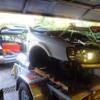After a bit of stuffing around I think I may have worked out the flaw in the system that is causing the major lack of boost. The 2 valves I have utilised as the ECV and ICV do not have a 100% seal when closed, I assumed this would be no issue for the ECV as the flow loss is minimal and may only be a minor issue for the ICV. Since running some tests I now believe this lack of seal is a bigger issue then I originally anticipated.
After closing up the cracks in the headers I decided to start taking measurements of the compressor outlet pressures of both turbo's under various conditions. I started by attaching a map sensor to the primaries compressor outlet to track it against MAP.
The measurements in these graphs are in KPA and are absolute, so 100kpa is atmo, 200kpa is 14.7psi boost, etc. The red line up top is MAP, the green line up top marked sensor01 is the compressor outlet. As expected both lines are basically tracking each other through the rev range and have near equal readings.

A reading was then taken from the secondaries compressor outlet. At this stage the ecv has been set to remain full closed until 4250rpm where it will switch to full open. There should be no pre-spool at all however in the graph you can see that secondary pressure is building with rpm, although at a reduced rate compared to MAP. The vertical blue line in the center of the image has been placed at 4250rpm, you can see to the right of this line that the pressure from the secondary has begun to ramp up, indicating the ecv has opened fully as it was supposed to. To the left of the line it should be closer to 100kpa as the ECV was closed so the higher pressure reading indicates that either the ICV is leaking too much boost down into the secondaries charge pipe or the ECV is leaking too much exhaust and is robbing the primary of the energy it requires.

Next test was to apply vacuum to the normally positive port of the ECV actuator in an attempt to 'lock' it shut. In the graph pressure from the secondary builds very similarly to the image in the previous graph. Considering the ECV was not meant to open in this test, it adds further weight that the valve's are leaking too much.

The ICV was then removed and replaced with some wooden plates to 100% block the flow of the secondaries intake. Again the secondary measured positive pressure and this time surging was recorded in the graph as the flow had nowhere to go but back through the turbo. Primary boost was still unacceptable at this point.

The same thing was then done with the ECV as well. It was removed and the exhaust was blocked with a plate. The primary now finally came to life, building boost very rapidly in comparison to previous results. Boost, and power, was picking up strongly from 2500rpm and was easily hitting max boost at 250kpa. The wastegate finally got to do something at this point too.

So it seems that these results are indicating that either the ECV was being pushed open prematurely by the exhaust pressure (unlikely being a butterfly valve) or that more likely the fact they don't seal 100% is stealing too much energy from the primary. Going with the latter I now need to either work out how to somehow modify the valves so they seal better, or source some better units that will seal better in the first place.
This is an image of one of the valves, you can see the small ring of light around the plate that shows how they don't seal correctly.

I also took an image of a run I did with the ecv set to remain open so the system was running as a parallel setup. The green line is also measuring the secondary to gauge it's response in comparison to the primary. It doesn't begin to ramp up until approximately 4700rpm.

I also pulled close to 10% out of the fuel map in most boost regions. This changed the AFR to read somewhere between 13-13.5 in most areas but the engine is definitely happier at this AFR. The plugs are now healthy looking too instead of being caked in soot.
I am all ears if anybody has any recommendations on where I can source some better valves or how I can modify these ones.



































